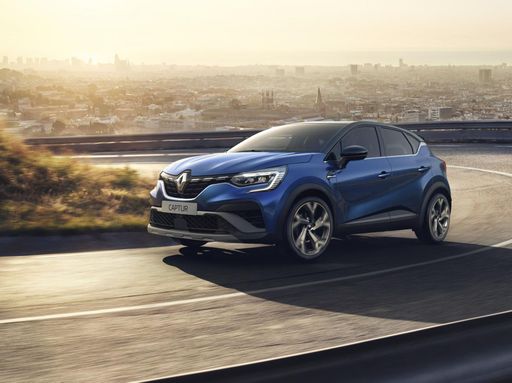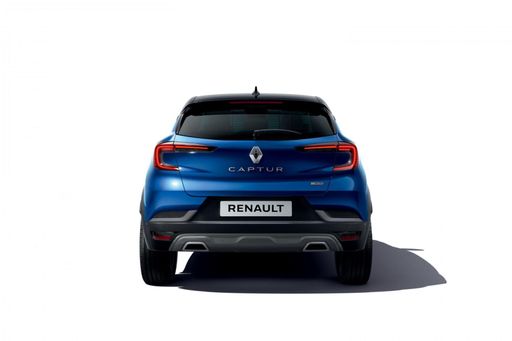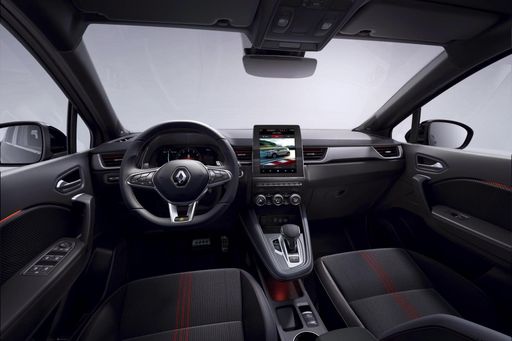The compact SUV segment is one of the most competitive in the automotive market, with manufacturers vying to offer the best blend of performance, style, and technology. Two prominent contenders in this arena are the 2024 Ford Kuga and the 2024 Renault Captur. In this article, we will compare these two models in-depth, examining their technical specifications, innovative features, and overall appeal to help you make an informed decision.
Ford Kuga vs Renault Captur – Differences & prices compared
Everyday use, family trips or long-distance drives – here’s where the differences show.
Discover whether Ford Kuga or Renault Captur fits your lifestyle better.
Design and Dimensions
Starting with aesthetics, both the Ford Kuga and the Renault Captur boast urban-friendly designs that cater to modern tastes. The Kuga, measuring between 4604 mm to 4645 mm in length, 1882 mm in width, and 1675 mm in height, projects a robust and premium SUV stance. Its well-sculpted curves cater to an athletic appearance, giving it a commanding presence on the road.
The Captur, in contrast, is more compact at 4239 mm long, 1797 mm wide, and 1575 mm tall, making it ideal for city driving. Its sleek lines and vibrant color options appeal to a younger demographic looking for flair as well as functionality.
Engine Options and Performance
When it comes to engine choices, both vehicles offer a variety that caters to different preferences. The Ford Kuga provides an impressive lineup of engines, including petrol variants, a full hybrid, and a plug-in hybrid. The power ranges from 150 HP to a thrilling 243 HP, with acceleration times varying from 9.5 seconds to an exhilarating 7.3 seconds for the sportier variants. Kuga's torque peaks at 240 Nm and it features options for both front-wheel and all-wheel drive, enhancing its versatility for various driving conditions.
On the other hand, the Renault Captur offers a more modest range of engines but still maintains competitive output with power figures up to 158 HP. The Captur's acceleration performance ranges from 8.5 seconds for the more powerful models to 14.3 seconds, depending on the variant. The Captur utilizes a front-wheel-drive layout, leaning towards fuel efficiency with consumption figures as low as 4.7 L/100 km.
Fuel Efficiency and Environmental Considerations
One of the key selling points for car buyers today is fuel efficiency and environmental impact. The Ford Kuga, with its hybrid options, has notable consumption figures ranging from 0.9 L/100 km for the plug-in hybrid model to 6.4 L/100 km for the petrol variants. Its hybrid capabilities also allow for an electric range of up to 69 km, making it a strong contender for eco-conscious consumers.
The Renault Captur shines in this regard with its Full Hybrid and Petrol MHEV options, achieving consumption figures between 4.7 L and 6.2 L/100 km, emphasizing efficiency. Additionally, the Captur emits between 106 g/km and 139 g/km of CO2, putting it in a decent position amongst its competitors for environmentally aware buyers.
Interior Space and Technology
Both vehicles provide ample interior space for five passengers. The Kuga offers a more robust trunk capacity at 412 liters, compared to the Captur's 326 liters and its top variant, which can expand to 422 liters if the rear seats are folded down. Inside, the Ford Kuga prioritizes comfort with its spacious layout and higher-end materials, fitting for a family-oriented SUV.
The Captur, meanwhile, impresses with its tech-savvy interfaces and user-friendly infotainment systems. Many users appreciate the customizable interior aesthetics and the quality of materials used, appealing to a youthful demographic that desires connectivity features such as smartphone integration and advanced driver-assistance systems.
Conclusion: Which One Should You Choose?
In conclusion, both the 2024 Ford Kuga and the Renault Captur possess unique attributes that cater to different buyer preferences. If you’re looking for power, a variety of engine options, and more space, the Kuga could be the better investment. However, if you prioritize efficiency, a modern design, and cutting-edge technology, the Captur may suit your needs better.
Ultimately, your decision will hinge on your personal priorities: performance versus efficiency, space versus technology. Whichever you choose, both models represent strong entries into the compact SUV market.
Here’s where it gets real: The technical differences in detail
Costs and Efficiency:
Price and efficiency are key factors when choosing a car – and this is often where the real differences emerge.
Renault Captur has a decisively advantage in terms of price – it starts at 21100 £, while the Ford Kuga costs 34200 £. That’s a price difference of around 13114 £.
Fuel consumption also shows a difference: Ford Kuga manages with 2.80 L and is therefore clearly more efficient than the Renault Captur with 4.50 L. The difference is about 1.70 L per 100 km.
Engine and Performance:
Power, torque and acceleration say a lot about how a car feels on the road. This is where you see which model delivers more driving dynamics.
When it comes to engine power, the Ford Kuga has a significantly edge – offering 243 HP compared to 143 HP. That’s roughly 100 HP more horsepower.
In acceleration from 0 to 100 km/h, the Ford Kuga is clearly perceptible quicker – completing the sprint in 7.30 s, while the Renault Captur takes 8.90 s. That’s about 1.60 s faster.
In terms of top speed, the Ford Kuga performs barely noticeable better – reaching 200 km/h, while the Renault Captur tops out at 180 km/h. The difference is around 20 km/h.
There’s also a difference in torque: Renault Captur pulls minimal stronger with 265 Nm compared to 240 Nm. That’s about 25 Nm difference.
Space and Everyday Use:
Cabin size, boot volume and payload all play a role in everyday practicality. Here, comfort and flexibility make the difference.
Both vehicles offer seating for 5 people.
In curb weight, Renault Captur is to a small extent lighter – 1323 kg compared to 1526 kg. The difference is around 203 kg.
In terms of boot space, the Renault Captur offers hardly perceptible more room – 422 L compared to 412 L. That’s a difference of about 10 L.
In maximum load capacity, the Ford Kuga performs to a small extent better – up to 1534 L, which is about 171 L more than the Renault Captur.
When it comes to payload, Ford Kuga to a small extent takes the win – 550 kg compared to 453 kg. That’s a difference of about 97 kg.
Who wins the race?
The Ford Kuga proves to be wins the duel decisively and therefore becomes our DriveDuel Champion!
Ford Kuga is the better all-rounder in this comparison.
 @ Ford Motor Company / Ford Media Center
@ Ford Motor Company / Ford Media Center
Ford Kuga
Ford Kuga
The Kuga is Ford’s adaptable family SUV that blends usable space with a surprisingly lively driving character, making daily commutes and weekend escapes equally enjoyable. With smart interior packaging, an easy-to-use infotainment setup and composed road manners, it’s a sensible choice for buyers who want a bit of fun without the fuss.
details @ Ford Motor Company / Ford Media Center
@ Ford Motor Company / Ford Media Center
 @ Ford Motor Company / Ford Media Center
@ Ford Motor Company / Ford Media Center
 @ Ford Motor Company / Ford Media Center
@ Ford Motor Company / Ford Media Center
Renault Captur
The Renault Captur is a cheeky little crossover that pairs city-friendly agility with a roomy, well-thought-out cabin and enough style to turn heads at the lights. It’s a sensible choice for buyers who want practical versatility and a dash of personality on their daily drives, without taking itself too seriously.
details @ Renault Group Media
@ Renault Group Media
 @ Renault Group Media
@ Renault Group Media
 @ Renault Group Media
@ Renault Group Media
 @ Renault Group Media
@ Renault Group Media
 @ Ford Motor Company / Ford Media Center
@ Ford Motor Company / Ford Media Center
|
 @ Renault Group Media
@ Renault Group Media
|
|
|
|
Costs and Consumption |
|
|---|---|
|
Price
34200 - 46300 £
|
Price
21100 - 28300 £
|
|
Consumption L/100km
2.8 - 6.8 L
|
Consumption L/100km
4.5 - 6 L
|
|
Consumption kWh/100km
-
|
Consumption kWh/100km
-
|
|
Electric Range
68 km
|
Electric Range
-
|
|
Battery Capacity
1.1 - 14.4 kWh
|
Battery Capacity
-
|
|
co2
55 - 154 g/km
|
co2
102 - 137 g/km
|
|
Fuel tank capacity
42 - 54 L
|
Fuel tank capacity
48 L
|
Dimensions and Body |
|
|---|---|
|
Body Type
SUV
|
Body Type
SUV
|
|
Seats
5
|
Seats
5
|
|
Doors
5
|
Doors
5
|
|
Curb weight
1526 - 1859 kg
|
Curb weight
1323 - 1514 kg
|
|
Trunk capacity
412 L
|
Trunk capacity
326 - 422 L
|
|
Length
4604 - 4645 mm
|
Length
4239 mm
|
|
Width
1882 mm
|
Width
1797 mm
|
|
Height
1673 - 1681 mm
|
Height
1575 mm
|
|
Max trunk capacity
1534 L
|
Max trunk capacity
1276 - 1363 L
|
|
Payload
541 - 550 kg
|
Payload
376 - 453 kg
|
Engine and Performance |
|
|---|---|
|
Engine Type
Petrol, Full Hybrid, Plugin Hybrid
|
Engine Type
Full Hybrid, Petrol, Petrol MHEV
|
|
Transmission
Manuel, Automatic
|
Transmission
Automatic, Manuel
|
|
Transmission Detail
Manual Gearbox, CVT, Automatic Gearbox
|
Transmission Detail
Automatic Gearbox, Manual Gearbox, Dual-Clutch Automatic
|
|
Drive Type
Front-Wheel Drive, All-Wheel Drive
|
Drive Type
Front-Wheel Drive
|
|
Power HP
150 - 243 HP
|
Power HP
115 - 143 HP
|
|
Acceleration 0-100km/h
7.3 - 9.9 s
|
Acceleration 0-100km/h
8.9 - 12.3 s
|
|
Max Speed
195 - 200 km/h
|
Max Speed
180 km/h
|
|
Torque
240 Nm
|
Torque
160 - 265 Nm
|
|
Number of Cylinders
3 - 4
|
Number of Cylinders
3 - 4
|
|
Power kW
111 - 178 kW
|
Power kW
84 - 116 kW
|
|
Engine capacity
1496 - 2488 cm3
|
Engine capacity
1199 - 1789 cm3
|
General |
|
|---|---|
|
Model Year
2025
|
Model Year
2025
|
|
CO2 Efficiency Class
E, D, B
|
CO2 Efficiency Class
C, D, E
|
|
Brand
Ford
|
Brand
Renault
|
What drivetrain options does the Ford Kuga have?
The Ford Kuga is available as Front-Wheel Drive or All-Wheel Drive.
The prices and data displayed are estimates based on German list prices and may vary by country. This information is not legally binding.
